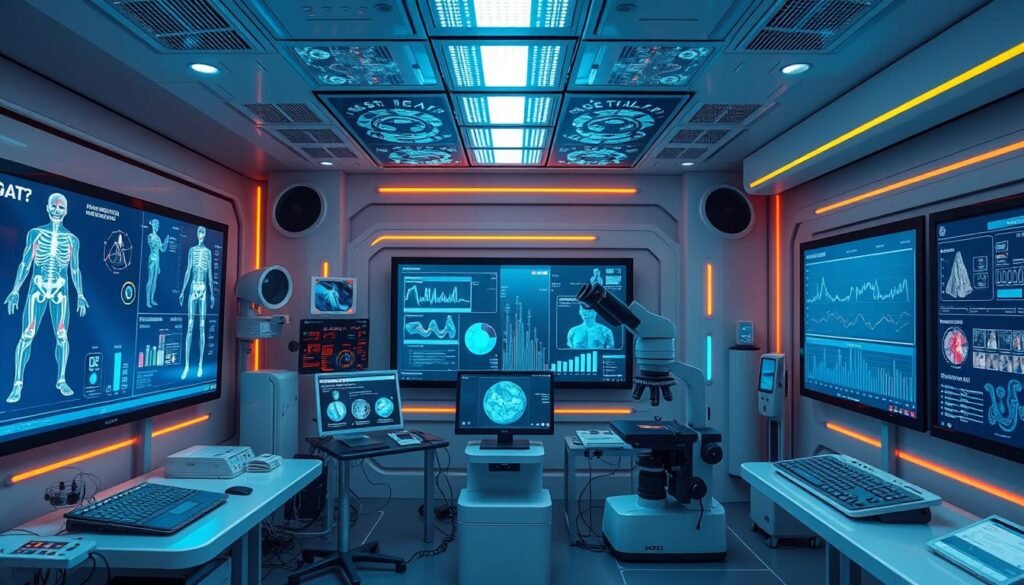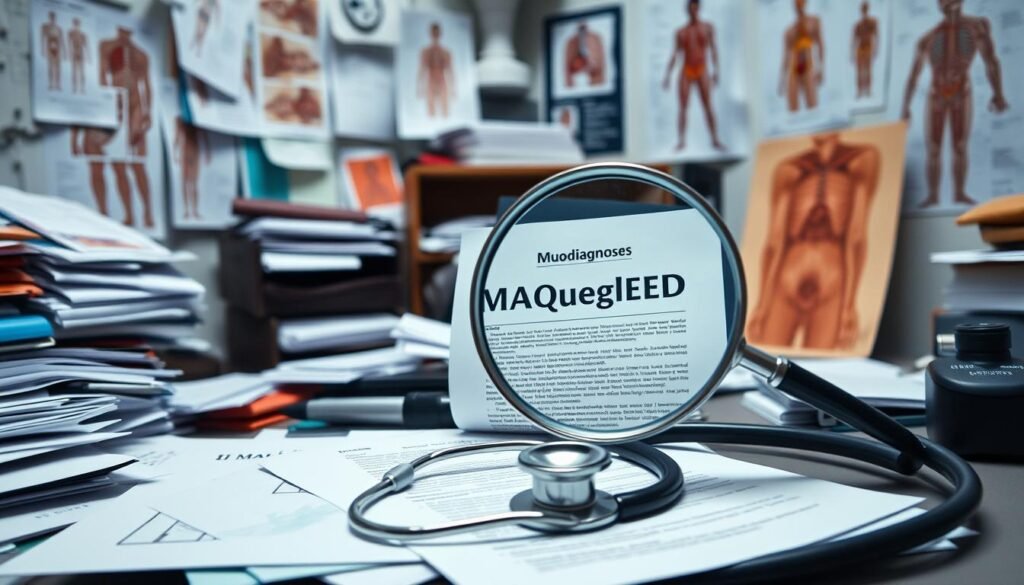Diagnostic errors: Imagine a simple mistake in medical diagnosis leading to serious problems. This could mean delayed or wrong treatment, harm to patients, and even death. In the United States, about 250,000 hospital patients face diagnostic errors each year. This results in over 40,000 deaths in adult ICUs every year.
Diagnostic errors are a big problem, causing one-third of severe harm malpractice claims. Almost 75% of these errors are linked to cancer, heart issues, and infections. So, how can we stop these errors and make sure diagnoses are accurate?

Key Takeaways
- Diagnostic errors contribute to over 40,000 deaths in adult ICUs annually, highlighting the need for accurate medical diagnosis.
- Almost 75% of diagnostic errors in the United States are attributed to cancer, cardiovascular events, and infections, emphasizing the importance of timely diagnosis.
- Misdiagnosis may occur in 10–15% of all diagnoses, according to expert opinion, making it crucial to implement strategies to prevent diagnostic errors.
- Hospitals can optimize the Electronic Health Record (EHR) to support accurate and timely diagnosis, reducing the risk of medical diagnosis errors.
- Conducting risk assessments and measuring diagnostic safety outcomes can help improve diagnostic practices and prevent healthcare mistakes.
- Diagnostic errors can result in significant healthcare costs, with the estimated annual cost of medical errors to the healthcare system being approximately $20 billion.
Understanding the Impact of Medical Diagnosis Errors
Medical diagnosis errors greatly affect patients, healthcare workers, and the healthcare system. Diagnostic error prevention is key to keeping patients safe and avoiding bad outcomes. Studies show that about 795,000 Americans die or are left disabled by these errors each year.
The costs of misdiagnosis are huge, with vascular issues, infections, and cancers causing 75% of serious harm. Clinical decision making and diagnostic testing are vital in stopping these mistakes. Cutting diagnostic errors by 50% for high-risk conditions could save 150,000 lives and prevent 150,000 permanent disabilities each year.
Statistics on Diagnostic Errors in Healthcare
Some important facts about diagnostic errors are:
- Stroke is the leading cause of serious harm from misdiagnosis, missed in 17.5% of cases.
- The overall average diagnostic error rate across diseases is estimated at 11.1%.
- Diagnosis errors are responsible for 10-30% of all medical errors.
Financial and Human Costs of Misdiagnosis
The financial toll of misdiagnosis is huge, with research funding for diagnostic error initiatives reaching $20 million per year. Yet, this is seen as under-resourced. The human costs are even more heartbreaking, with patients and families facing huge physical, emotional, and financial challenges.
Root Causes of Diagnostic Errors in Clinical Practice
Diagnostic errors happen for many reasons, like cognitive biases and poor communication. It’s key to know why these errors occur to stop them. Clinical decision-making mistakes can lead to wrong diagnoses, which can harm patients a lot.
Studies show that 5% to 15% of outpatient diagnoses are wrong. This shows we need better ways to prevent these mistakes.
To fix these problems, healthcare workers can do a few things: * Make sure teams talk well together * Teach ways to avoid thinking errors * Use tools like checklists to help make better decisions * Create a place where everyone feels safe to speak up
| Category | Description | Example |
|---|---|---|
| Cognitive biases | Errors in thinking and decision-making | Premature closure, anchoring bias |
| System-related errors | Errors due to system or process failures | Communication breakdowns, inadequate training |
By understanding why diagnostic errors happen and acting on it, healthcare can lower wrong diagnoses. This will help patients get better care.
Common Cognitive Biases Affecting Medical Decision-Making
Cognitive biases can greatly affect clinical decision making, causing diagnostic errors. It’s key to know these biases and their effects to improve patient safety. In the diagnostic process, biases like confirmation and anchoring can sway medical decisions, possibly causing wrong diagnoses.
Some common cognitive biases affecting medical decision-making include:
- Confirmation bias: the tendency to overvalue information that confirms what we already believe, leading to wrong diagnoses.
- Anchoring bias: the tendency to rely too much on the first piece of information, even if it’s wrong, causing misdiagnosis.
- Overconfidence in clinical judgment: thinking one’s diagnoses are always right, which can lead to diagnostic errors.
To fight these biases, strategies like diagnostic testing and guided reflection can help. They can enhance diagnostic reasoning and lower the impact of cognitive biases on patient safety.
By tackling these cognitive biases, healthcare professionals can better the diagnostic process. This can lower the chance of diagnostic errors, boosting patient safety and health outcomes.
The Role of Communication in Preventing Misdiagnosis
Good communication between patients and doctors is key for patient safety and avoiding mistakes in diagnosis. A study showed that 27% of medical lawsuits come from communication problems. This shows how important it is to talk clearly during the diagnostic process.
To stop diagnostic error prevention, doctors need to talk well with patients. They should listen to what patients say and explain their diagnosis and treatment plans clearly. This can be done by listening well, showing empathy, and explaining medical terms and procedures in simple ways.
Some important ways to communicate well include:
- Explaining complex medical ideas in simple terms
- Giving patients written instructions and info
- Encouraging patients to ask questions and share their worries
By focusing on good communication, doctors can lower the chance of making mistakes in diagnosis. This can also make patients happier and healthier.
| Communication Strategy | Effectiveness |
|---|---|
| Clear explanations of diagnosis and treatment | High |
| Active listening and empathy | High |
| Providing written instructions and information | Medium |
Essential Steps in the Diagnostic Process
Getting a correct diagnosis is key to avoiding medical mistakes. A detailed patient history, physical check-up, and tests are crucial. The NCBI Bookshelf says these steps are vital for accurate diagnosis.
Good communication helps lower diagnostic errors. Including family in the patient history can improve accuracy, especially for older adults with memory loss. Also, open discussion about uncertainty can help avoid mistakes.
To boost diagnostic accuracy, healthcare providers must follow best practices. This means thoroughly getting patient info, doing comprehensive physical exams, and selectively choosing tests.
Some important things to consider when choosing tests include:
- Ordering tests based on clinical suspicion and patient presentation
- Interpreting test results in the context of the patient’s clinical history and physical examination
- Avoiding unnecessary testing to reduce the risk of false positives and false negatives
By following these steps and considering these factors, healthcare providers can improve accuracy. This helps prevent medical errors and makes better clinical decisions.
Technology and Tools for Improving Diagnostic Accuracy
Improving diagnostic accuracy is key in healthcare. Technology is a big help in this area. Tools like clinical decision support systems can cut down on mistakes. Finding the root cause of errors is also vital.
The National Institutes of Health say health IT includes many technologies. These include electronic health records, clinical decision support systems, and medical imaging systems. These tools give doctors the right info at the right time.
Some important technologies for better diagnosis are:
- Clinical decision support systems
- AI-assisted diagnosis tools
- Medical imaging systems
These tools help lower mistakes and better patient care. For instance, AI tools can spot health issues in images. Clinical support systems give doctors the best advice.
Technology and tools greatly help in making diagnoses more accurate. By using these, doctors can give better care and improve patient results.

| Technology | Description | Benefits |
|---|---|---|
| Clinical decision support systems | Provide healthcare providers with evidence-based recommendations | Improve diagnostic accuracy, reduce errors |
| AI-assisted diagnosis tools | Analyze medical images and identify potential health issues | Improve diagnostic accuracy, reduce errors |
| Medical imaging systems | Provide accurate and timely medical images | Improve diagnostic accuracy, reduce errors |
Building a Culture of Diagnostic Safety
Creating a culture of diagnostic safety is key to reducing medical misdiagnosis and diagnostic mistakes. This can be done by focusing on transparency, accountability, and always looking to improve diagnostic processes. The National Academy of Sciences says most people will face at least one diagnostic error in their lives.
A study found that cognitive and systems-based factors cause most diagnostic errors. These include failed heuristics and poor communication. To fix this, healthcare providers can offer education and training on diagnosis. They can also use Clinical Decision Support (CDS) tools.
Some important steps to build a safe diagnostic culture include:
- Engaging patients in diagnostic safety
- Appointing dedicated diagnostic safety champions
- Adapting trigger tools to identify safety events
By taking these steps, healthcare providers can lower diagnostic errors. This leads to better patient care and saves money. It also cuts down on medical misdiagnosis and diagnostic mistakes.
| Strategy | Description |
|---|---|
| Education and Training | Focus on the diagnostic process to enhance clinical reasoning and reduce biases |
| Clinical Decision Support (CDS) tools | Use technology to improve diagnostic accuracy and reduce errors |
| Patient Engagement | Involve patients in the diagnostic process to improve safety and outcomes |
Patient Engagement Strategies to Reduce Diagnostic Errors
Patient engagement is key to cutting down diagnostic errors. Healthcare providers need to talk clearly with patients and use their feedback. This means using simple language, listening well, and sharing important info about their health.
Studies show nearly 800,000 Americans die or are disabled yearly from wrong diagnoses. Misdiagnosis is a big reason for malpractice claims, especially in cancer cases. If patients are more involved, they might avoid these errors. Trusting their doctors, they’re less likely to sue for missed or late diagnoses.
Some ways to engage patients include:
- Using tools like SBAR (Situation, Background, Assessment, Recommendation) to talk better
- Encouraging patients to ask questions and share their worries
- Giving clear, easy-to-understand info about their health and treatment
By focusing on patient safety and cutting down on diagnostic mistakes, doctors can do better for their patients. Good communication and patient involvement are crucial for these goals.
Healthcare teams face challenges like staff shortages, burnout, and more patients. But, by working on patient engagement and communication, doctors can lower the chance of mistakes. This makes care safer for everyone.
| Strategy | Benefit |
|---|---|
| Patient engagement | Reduces risk of diagnostic errors |
| Effective communication | Improves patient outcomes |
| Standardized tools | Enhances communication and reduces errors |
Systematic Approaches to Error Prevention
Healthcare errors, like misinterpretation and diagnostic mistakes, are big worries in medicine. Recent stats show medical errors are the third leading cause of death in the US. About 400,000 hospitalized patients face preventable harm each year.
To stop these errors, we can use systematic methods. For example, checklists and quality assurance protocols help a lot. A study showed checklists cut surgical complications by 35%.
Some important ways to stop diagnostic errors include:
- Setting up quality assurance to make sure diagnoses are right
- Using checklists to lower errors in medical actions
- Boosting communication between healthcare workers to avoid misinterpretation
By using these methods, healthcare workers can lower error rates and better patient outcomes. As Graber ML points out, systematic prevention can cut down on diagnostic errors. This ensures patients get the right diagnosis on time.

| Strategy | Description |
|---|---|
| Checklist Implementation | Using checklists to reduce errors in medical procedures |
| Quality Assurance Protocols | Implementing protocols to ensure accurate diagnoses |
Documentation and Follow-up Protocols
Accurate documentation and follow-up are key to avoiding diagnostic accuracy problems. They help ensure patients get the care they need quickly and well. MedPro Group’s data from 2011 to 2020 shows that almost 1 in 5 claims are due to documentation issues. This shows how vital proper documentation is in preventing medical diagnostic inaccuracies.
Some common documentation problems include not enough or missing information. These can lead to diagnosing errors. Issues like not documenting follow-up attempts or missing records in patient files are examples.
To fix these problems, healthcare needs good documentation policies. These policies should require detailed notes on patient history, treatment plans, and patient education. This ensures care is continuous and decisions are informed. By following these policies, healthcare providers can lower the chance of diagnostic accuracy problems and improve patient care.
Also, it’s crucial to have the right timeframes for documenting after patient visits. This ensures accurate records and helps avoid medical diagnostic inaccuracies. By focusing on accurate documentation and follow-up, healthcare providers can better patient outcomes and lower the risk of diagnosing errors.
Team-Based Approaches to Diagnostic Excellence
Healthcare is moving towards team work to better diagnose and cut down on mistakes. This change comes from knowing that delayed diagnosis and medical mistakes can be very harmful. By focusing on misdiagnosis prevention, hospitals can improve patient care and save money on mistakes.
The National Academies of Sciences, Engineering, and Medicine (NASEM) say most people will face at least one diagnostic error. To fix this, doctors are teaming up more. This teamwork, like working together and checking each other’s work, makes diagnosis better and mistakes fewer.
Interdisciplinary Collaboration
When doctors from different fields work together, they can do a better job diagnosing and treating patients. This teamwork has many benefits:
- It makes communication better among healthcare workers.
- It leads to better care and results for patients.
- It cuts down on mistakes and harm to patients.
Peer Review Processes
Peer review means doctors check and give feedback on each other’s work. This method has been shown to make diagnosis more accurate and reduce mistakes. Some advantages of peer review include:
- It leads to more accurate diagnoses and better patient care.
- It reduces mistakes and harm to patients.
- It helps doctors learn and get better at their jobs.
By using team work, like doctors from different fields working together and checking each other’s work, hospitals can do a better job. This leads to better care for patients and saves money on mistakes.
| Approach | Benefits |
|---|---|
| Interdisciplinary Collaboration | Improved communication, enhanced patient care, reduced diagnostic errors |
| Peer Review Processes | Improved diagnostic accuracy, reduced diagnostic errors, enhanced healthcare professional education |
Conclusion: Creating a Framework for Diagnostic Excellence
To achieve diagnostic excellence, we need a team effort from healthcare providers, policymakers, and patient advocates. The National Academies of Sciences, Engineering, and Medicine (NASEM) point out that most healthcare places don’t have the right systems to spot and fix diagnostic errors. But, the push for diagnostic error awareness and setting standards for better diagnosis shows we’re moving in the right direction.
Places like the Committee to Improve Clinical Diagnosis (CICD) at Geisinger show how important it is to collect and use data to improve accurate diagnosis. They looked at over 220 cases where diagnoses were missed. This helped them share important lessons with doctors, encouraging ongoing learning and improvement.
Going forward, healthcare leaders must focus on measuring and improving diagnostic quality. With help from policymakers and federal agencies, we can work together to make healthcare safer and better for everyone.
FAQ
What are the severe consequences of diagnostic mistakes?
Diagnostic mistakes can lead to serious issues. These include delayed or wrong treatments, harm to patients, and even death. It’s vital to understand how crucial accurate medical diagnosis is. We must also find ways to stop these errors.
What is the impact of medical diagnosis errors on the healthcare system?
Medical diagnosis errors have a big impact. They affect patients, healthcare workers, and the whole healthcare system. Knowing the stats on these errors, their costs, and types is key. This knowledge helps in creating plans to avoid these mistakes.
What are the common causes of diagnostic errors in clinical practice?
Several factors cause diagnostic errors. These include cognitive biases, poor communication, and not enough training. Knowing why these errors happen is important. It helps in making plans to stop them.
How can cognitive biases influence medical decision-making?
Cognitive biases can affect how doctors make decisions. This can lead to diagnostic errors. It’s important to understand these biases and their effects. This knowledge helps in finding ways to lessen their impact.
What is the role of communication in preventing diagnostic errors?
Good communication is key in avoiding diagnostic errors. Doctors must talk clearly with patients. They should listen to their concerns and explain their diagnosis and treatment plans well.
What are the essential steps in the diagnostic process?
The diagnostic process has important steps. These include taking the patient’s history, doing a physical exam, and running tests. Doctors must follow best practices for these steps to make accurate diagnoses.
How can technology and tools improve diagnostic accuracy?
Technology and tools can greatly help in making diagnoses more accurate. Doctors should keep up with new technology. They should use it in their work to reduce errors.
What is the importance of creating a culture of diagnostic safety?
A culture of diagnostic safety is crucial. It helps in reducing errors. Doctors must focus on being open, accountable, and always looking to improve. This ensures patients get the right diagnosis on time.
How can patient engagement help reduce diagnostic errors?
Engaging patients is vital in cutting down diagnostic errors. Doctors should talk well with patients, listen to their feedback, and encourage them to be involved in their care.
What are the systematic approaches to error prevention?
There are systematic ways to prevent diagnostic errors. Doctors should use checklists, quality checks, and other methods. These ensure patients get the right diagnosis and care.
Why are accurate documentation and follow-up protocols important?
Accurate records and follow-ups are critical. They help prevent diagnostic errors. Doctors must document patient info correctly and check in with patients. This ensures they get the care they need.
How can team-based approaches improve diagnostic excellence?
Working together can improve diagnostic skills. Doctors should work as a team, share ideas, and review each other’s work. This teamwork helps in giving patients accurate and timely diagnoses.
Source Links
- https://www.advisory.com/daily-briefing/2022/07/29/diagnostic-errors
- https://psnet.ahrq.gov/perspective/improving-diagnostic-safety-and-quality
- https://www.ncbi.nlm.nih.gov/books/NBK499956/
- https://www.hopkinsmedicine.org/news/newsroom/news-releases/2023/07/report-highlights-public-health-impact-of-serious-harms-from-diagnostic-error-in-us
- https://www.ahrq.gov/downloads/pub/advances/vol2/schiff.pdf
- https://care.choc.org/the-causes-and-prevention-of-diagnostic-errors-in-medicine/
- https://www.ncbi.nlm.nih.gov/books/NBK338594/
- https://www.ncbi.nlm.nih.gov/books/NBK570638/
- https://www.ama-assn.org/delivering-care/ethics/4-widespread-cognitive-biases-and-how-doctors-can-overcome-them
- https://pmc.ncbi.nlm.nih.gov/articles/PMC7838049/
- https://pmc.ncbi.nlm.nih.gov/articles/PMC6694717/
- https://pmc.ncbi.nlm.nih.gov/articles/PMC2359508/
- https://www.aafp.org/pubs/afp/issues/2021/0615/p757.html
- https://www.ncbi.nlm.nih.gov/books/NBK338593/
- https://www.aafp.org/pubs/afp/issues/2016/0915/p426.html
- https://www.cdc.gov/patient-safety/hcp/hospital-dx-excellence/index.html
- https://www.ncbi.nlm.nih.gov/books/NBK338590/
- https://www.gao.gov/blog/machine-learnings-potential-improve-medical-diagnosis
- https://www.ncbi.nlm.nih.gov/books/NBK555525/
- https://pmc.ncbi.nlm.nih.gov/articles/PMC9640494/
- https://medcitynews.com/2024/11/strategies-to-reduce-diagnostic-errors-in-patient-care-settings/
- https://qualitysafety.bmj.com/content/22/Suppl_2/ii33
- https://bmcmedinformdecismak.biomedcentral.com/articles/10.1186/s12911-019-0901-1
- https://www.medpro.com/documentation-in-dx-malpractice-cases
- https://www.cms.gov/outreach-and-education/medicare-learning-network-mln/mlnproducts/downloads/certmedrecdoc-factsheet-icn909160.pdf
- https://pmc.ncbi.nlm.nih.gov/articles/PMC10664282/
- https://www.medpro.com/improving-diagnosis-teamwork-diagnostic-team
- https://pmc.ncbi.nlm.nih.gov/articles/PMC7402609/
- https://www.moore.org/article-detail?newsUrlName=transforming-health-care-how-groups-are-working-to-advance-diagnostic-excellence-through-innovative-measurement-approaches
Click here to learn more about this topic in a related article.





